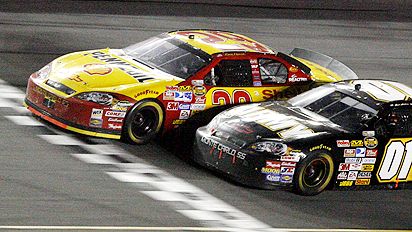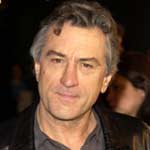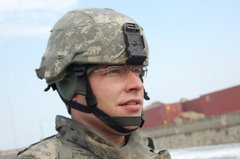The families don't know her, but she knows their lost sons and daughters.
And she spends a lot of time in Arlington, Virginia, making sure they aren't forgotten.
By JOHN BARRY
Published February 18, 2007
Courtesy of John Barry and the St. Petersburg (Florida) Times
ARLINGTON, Virginia - The widows and children had bundled themselves in parkas and snowsuits. They looked very young, standing in a frozen field of white headstones at Arlington National Cemetery. It was 18 degrees, and the wind was blowing at a raw 20 mph. Each one clutched a screwdriver to punch holes in the icy ground. Holly darted among them with boxes of silk roses, her head bobbing above theirs.
She is a 6-foot-2 blond with the lanky physique of a model, except layered in sweatshirts. "Amazon infidel," she calls herself.

She is out among the headstones every week and knows the stories behind every one. The widows and the kids took the roses and scattered among the headstones of Section 60. It's the section set aside for men and women killed in action in Iraq and Afghanistan. About 300 are laid to rest there.
The widows made their way through the rows. At their husbands' graves, they knelt and punched at the stiff sod with their screwdrivers. Some of them had small hammers, and you could hear their tap-tapping. The children helped. When they had made their holes, they inserted the wire stems of the silk red roses. They knelt quietly in the wind.
The word had gone out by Internet that Holly would be at Section 60 on the Saturday before Valentine's Day. Last year, she spread most of the roses herself. But this year, widows and children, mothers and fathers had heard about this woman named Holly and drove or flew in from all over the country. There were about 50 of them.
Almost no one knew her full name: Holly Holeman. She was just Holly to them, a mysterious e-mailer who had sent photos of headstones, of flowers by the graves. All year, the e-mails came, far-off reassurances that someone was taking care of the graves.
Eventually, they learned that her day job is making floral arrangements and delivering them to funerals at Arlington.
Holly had found the families through a Web site run by a Long Island businessman named Michael Patterson. It has biographies and news accounts of all American casualties from Iraq and Afghanistan buried in Section 60. Patterson started it while researching the history of the cemetery for a book he has always wanted to write. Now keeping up the Web site has overtaken his book.
He got one of Holly's mysterious e-mails one day. "She wouldn't give me her last name. She said, 'Here's a photo of a new headstone. Use it if you think it's worthwhile.' " He did, and soon she was sending dozens more photos. He posted them: Courtesy of Holly.
The families tried to figure it out. Each thought about the day of the funeral. Was she that tall woman they saw standing in the distance, the one partly behind a tree?
Paula Davis ran into her a year ago on her regular Sunday visit to the grave of her son Justin. He was 19 when he died last June on a rooftop in southeastern Afghanistan. Friendly fire was the suspected cause.
Davis lives in Gaithersburg, Maryland, so she gets by to visit all the time, haunted by the fear that her son and all the others in Section 60 will soon be forgotten. She pictures a silent field, no visitors. "People go on with their lives," she says.
One Sunday, a tall, fast-talking woman approached Davis. She offered oatmeal cookies and coffee. Davis learned this woman wasn't about to forget anyone.
Everybody has a story like that. Beth Downs had randomly called a florist shop near Arlington Cemetery from her Florida home in Fort Walton Beach. She wanted a spray of flowers for her husband's new grave. She happened to get Holly on the phone.
Her husband, Air Force Major William Brian Downs, 40, had died in a crash in Iraq on May 30, 2005. He was helping train an Iraqi air force. He was aboard a Russian prop plane with three other airmen and an Iraqi pilot, surveying emergency landing strips. No one knows why the plane crashed or even who was flying it.
Each of the four Americans was buried separately. Then a later service was held for commingled remains of all five on the plane. The lost Iraqi pilot, Captain Ali Abass, became the only Iraqi laid to rest in Section 60.
The group funeral was a major political event, with a military contingent from Iraq present and the national media covering it. Holly saw a stunned young widow with three small children and hung back. Afterward, Beth went looking for the original grave that held most of her husband's remains. Holly drove past, stopped and introduced herself. She apologized at the same time, Beth recalls. "She said she wanted me to have privacy."
They didn't meet again until the Saturday before Valentine's.
Floridians Lee and Janine Woodliff had flown from Port Charlotte to Arlington Cemetery for their son's (Michael)birthday last August 20. He would have been 24. He was killed when a bomb blew apart his Humvee in Iraq on March 2, 2004. His parents had brought with them two suitcases packed with 300 silk roses. They spent two days putting one on each grave site.
"On the second day, Holly was there," Lee Woodliff says. "In a very kind and gentle way, she said she would help if we ever wanted anything."
Her photos of their son's headstone began arriving after they got home.
Jill Cockerham from Winston-Salem, North Carolina, says Holly knew all about her son Gray, a Marine, before they even met at the cemetery. She had read about him on Patterson's Web site. Gray Cockerham, 21, was killed by a roadside bomb on August 21, 2005.
"She knew about my son in elementary school."
As she talked on the Saturday before Valentine's Day, Cockerham made her way down the frozen rows with her rose and screwdriver. She surveyed the field.
"Each year the rows get deeper."
Among Holly and the families, gray-haired Tom Guggliuzza circulated with jugs of cocoa and coffee. He's retired. He's supposed to be living in Bangor, Pennsylvania. He came for his nephew's funeral at Arlington two years ago and never went home. He is at Section 60 three to five days a week. He reads to the dead.
Families send him letters, poems and books. He sits on a golf stool at grave sites and reads out loud. "I've learned to love these kids," he said. He was there on the previous Thursday, at the funeral for Army Specialist Nicholas Brown, 24, who was killed by a bomb on January 22. Tom saw Brown's widow, Sara, standing in the frigid wind with a month-old baby.
He said he has stayed longer in Virginia than he ever expected, but "I just can't leave them." He senses their spirits.
"I go through boxes of tissues," Tom said, pointing to a half-empty box of Kleenex beside him on the ground.
Holly doesn't cry.
"I'm here for the living," she said. She worries she might be off-putting to some families. She's taller than most of them; she flings sentences so fast they can't catch them all; she fears she appears "seemingly emotionless." She often hangs back. "I'm a little hard to take. I'm a stoic. I don't do tears with the widow. But I'm good in a trench."
She's single and works in a flower shop, on her feet all day binding blossoms together for weddings, birthdays, apologies and sad goodbyes. That's all she'll say about herself; this is about the soldiers.
She remembers the first one to come to Arlington National Cemetery from the Iraq war. He was Army Captain Russell Rippetoe, 27. He had manned a nighttime checkpoint in western Iraq on August 3, 2003. A car full of civilians approached. A pregnant woman got out and ran toward the soldiers, screaming. Rippetoe stepped toward her, and the car exploded. Rippetoe and two other soldiers were killed.
Holly was to deliver a floral arrangement to the funeral. An Army Ranger called her and asked her to bring along a camera to take a picture of the flowers. That was how it all started.
The mothers got to her. Her own mother had a philosophy about soldiers who die. Their wives go on; their mothers can't.
Holly stays behind, after the bugle has blown. The mothers know that she's there.
Most of the families had left by late afternoon. They had talked about getting together again at Easter to take the roses up. Holly saves them each year, sewing them on a blanket that she sometimes brings to Section 60 and lays under a large holly tree.
They all drove away. Holly dropped off leftover oatmeal cookies at the guardhouse at the Tomb of the Unknowns. She twisted the wire stem of a silk rose onto the crypt of her father, a sergeant in counterintelligence during World War II. He was 6-8. She got her height from him.
The day was fading. Her last chore was her strays. These were men and women technically not killed in action in Iraq, and therefore not buried in Section 60.
They are on Holly's rose list nonetheless.
So down the road at Section 66, she stopped her car at the grave of Taryn Ashley Robinson, 22, daughter of a major general. Her death last year was, in Holly's words, "the saddest, damnedest thing I've ever heard."
She had been an Air Force Academy graduate, a second lieutenant. She had been taking flight lessons in San Antonio, Texas. On Sept. 5, 2005, her small plane struck a giant power line.
The plane exploded, killing the instructor. She managed to crawl out of the wreckage on fire, her neck broken. A passerby found her, 80 percent of her body burned. She died in a burn unit after four months in an induced coma.
Holly knelt at her grave, punched her screwdriver in the ground, planted the silk rose. She remained kneeling. Her hands were red, windburned.
Taryn really belongs down the road in Section 60, she said.
"For my money, she's one of them."
John Barry can be reached at (727) 892-2258 or jbarry@sptimes.com.A message from Holly.
































